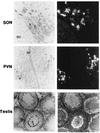Transgenic rats reveal functional conservation of regulatory controls between the Fugu isotocin and rat oxytocin genes
- PMID: 9356472
- PMCID: PMC25001
- DOI: 10.1073/pnas.94.23.12462
Transgenic rats reveal functional conservation of regulatory controls between the Fugu isotocin and rat oxytocin genes
Abstract
We have asked whether comparative genome analysis and rat transgenesis can be used to identify functional regulatory domains in the gene locus encoding the hypothalamic neuropeptides oxytocin (OT) and vasopressin. Isotocin (IT) and vasotocin (VT) are the teleost homologues of these genes. A contiguous stretch of 46 kb spanning the Fugu IT-VT locus has been sequenced, and nine putative genes were found. Unlike the OT and vasopressin genes, which are closely linked in the mammalian genome in a tail-to-tail orientation, Fugu IT and VT genes are linked head to tail and are separated by five genes. When a cosmid containing the Fugu IT-VT locus was introduced into the rat genome, we found that the Fugu IT gene was specifically expressed in rat hypothalamic oxytocinergic neurons and mimicked the response of the endogenous OT gene to an osmotic stimulus. These data show that cis-acting elements and trans-acting factors mediating the cell-specific and physiological regulation of the OT and IT genes are conserved between mammals and fish. The combination of Fugu genome analysis and transgenesis in a mammal is a powerful tool for identifying and analyzing conserved vertebrate regulatory elements.
Figures






Similar articles
-
Sequence and organization of coelacanth neurohypophysial hormone genes: evolutionary history of the vertebrate neurohypophysial hormone gene locus.BMC Evol Biol. 2008 Mar 26;8:93. doi: 10.1186/1471-2148-8-93. BMC Evol Biol. 2008. PMID: 18366747 Free PMC article.
-
Neurone-specific expression and regulation of the pufferfish isotocin and vasotocin genes in transgenic mice.J Neuroendocrinol. 2003 Nov;15(11):1027-36. doi: 10.1046/j.1365-2826.2003.01090.x. J Neuroendocrinol. 2003. PMID: 14622432
-
Structure and organization of the isotocin and vasotocin genes from teleosts.Adv Exp Med Biol. 1995;395:629-38. Adv Exp Med Biol. 1995. PMID: 8714027 Review.
-
Something fishy in the rat brain: molecular genetics of the hypothalamo-neurohypophysial system.Bioessays. 1998 Sep;20(9):741-9. doi: 10.1002/(SICI)1521-1878(199809)20:9<741::AID-BIES7>3.0.CO;2-J. Bioessays. 1998. PMID: 9819563 Review.
-
Characterization of the neurohypophysial hormone gene loci in elephant shark and the Japanese lamprey: origin of the vertebrate neurohypophysial hormone genes.BMC Evol Biol. 2009 Feb 26;9:47. doi: 10.1186/1471-2148-9-47. BMC Evol Biol. 2009. PMID: 19243634 Free PMC article.
Cited by
-
Conserved regulation of the lymphocyte-specific expression of lck in the Fugu and mammals.Proc Natl Acad Sci U S A. 2002 Mar 5;99(5):2936-41. doi: 10.1073/pnas.032680599. Epub 2002 Feb 26. Proc Natl Acad Sci U S A. 2002. PMID: 11867707 Free PMC article.
-
Sequence and organization of coelacanth neurohypophysial hormone genes: evolutionary history of the vertebrate neurohypophysial hormone gene locus.BMC Evol Biol. 2008 Mar 26;8:93. doi: 10.1186/1471-2148-8-93. BMC Evol Biol. 2008. PMID: 18366747 Free PMC article.
-
Genomic structure and comparative analysis of nine Fugu genes: conservation of synteny with human chromosome Xp22.2-p22.1.Genome Res. 1999 May;9(5):437-48. Genome Res. 1999. PMID: 10330123 Free PMC article.
-
Genomic sequence analysis of Fugu rubripes CFTR and flanking genes in a 60 kb region conserving synteny with 800 kb of human chromosome 7.Genome Res. 2000 Aug;10(8):1194-203. doi: 10.1101/gr.10.8.1194. Genome Res. 2000. PMID: 10958637 Free PMC article.
-
Regulatory domains in the intergenic region of the oxytocin and vasopressin genes that control their hypothalamus-specific expression in vitro.J Neurosci. 2003 Aug 27;23(21):7801-9. doi: 10.1523/JNEUROSCI.23-21-07801.2003. J Neurosci. 2003. PMID: 12944509 Free PMC article.
References
-
- Brenner S, Elgar G, Sandford R, Macrae A, Venkatesh B, Aparicio S. Nature (London) 1993;366:265–268. - PubMed
-
- Venkatesh B, Tay B H, Elgar G, Brenner S. J Mol Biol. 1996;259:655–665. - PubMed
-
- How G F, Venkatesh B, Brenner S. Genome Res. 1996;6:1185–1191. - PubMed
-
- Hara Y, Battey J, Gainer H. Mol Brain Res. 1990;8:319–324. - PubMed
MeSH terms
Substances
Associated data
- Actions
LinkOut - more resources
Full Text Sources
Other Literature Sources

